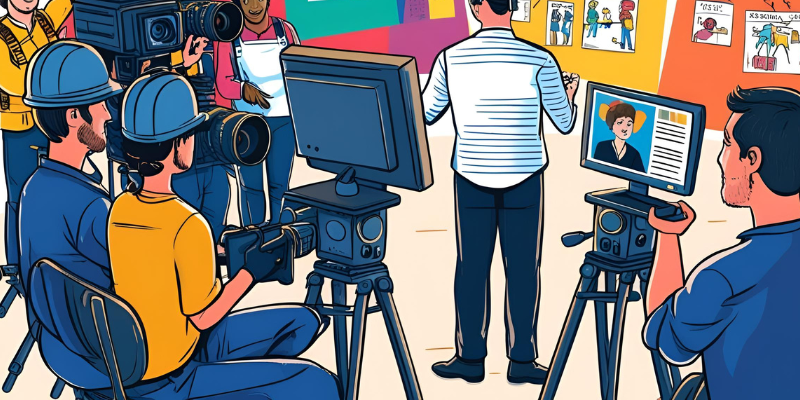Movies are magical—but the real magic happens far from the silver screen. Behind every heart-pounding action sequence, emotional monologue, or breathtaking visual, there’s a world of hard work, creativity, and planning. While audiences see the final product, there’s a vast behind-the-scenes process that brings our favorite films to life. In this blog, we’ll explore the major stages of movie-making—from initial concept to final cut—and reveal the unsung heroes who make cinematic dreams a reality.
1. Concept and Development
Every great movie begins with an idea. This could be a unique storyline, a book adaptation, or even a remake of a classic. In the development stage, the idea is fleshed out into a screenplay or script. Writers draft the storyline, characters, and dialogue, often going through multiple rewrites and feedback rounds from producers or studios. At this stage:
- Writers create story outlines or full scripts
- Producers secure rights (if adapting a book or comic)
- A budget and rough timeline are proposed
This is also when a director may be attached to the project, influencing the tone and vision of the film.
2. Pre-Production: Planning the Blueprint
Once a script is finalized and funding is secured, the pre-production phase kicks off. This is the stage where the groundwork is laid out:
- Casting: Actors are selected for roles through auditions or based on previous work
- Storyboarding: Artists draw visual representations of key scenes to plan shots
- Location Scouting: Teams search for real-world or studio locations to shoot scenes
- Costume and Set Design: Designers create the visual identity of the film
Departments like cinematography, lighting, sound, and visual effects begin working on technical strategies. This phase is crucial—it determines how smoothly the actual filming will go.
3. Production: Lights, Camera, Action!
Now comes the most exciting phase—shooting the movie. This can take anywhere from a few weeks to several months, depending on the scale and complexity of the film. During production:
- Directors guide actors and camera teams to bring scenes to life
- Cinematographers manage lighting, camera angles, and movement
- Sound engineers capture clean dialogue and background noise
- Makeup and costume teams ensure continuity and style
Scenes are usually filmed out of order based on location availability and actor schedules. Each shot may be repeated several times from different angles to capture the best performance and coverage.
4. Post-Production: Where the Magic Happens
Once filming wraps, the real transformation begins. In post-production, editors take hours of raw footage and piece together the film’s final version. This involves:
- Video Editing: Cutting and rearranging scenes for pace, emotion, and clarity
- Sound Design: Adding effects, background scores, and voiceovers (ADR)
- Color Grading: Adjusting lighting and color tones to create visual consistency
- Visual Effects (VFX): Inserting CGI, green screen effects, and digital environments
- Music Composition: Creating original soundtracks or syncing existing music
This phase can last longer than filming itself. Films with extensive VFX—like Marvel movies or sci-fi epics—may spend over a year in post-production.
5. Marketing and Distribution
After the movie is completed, it’s time to build anticipation. Marketing teams develop promotional strategies to ensure the film reaches audiences around the world:
- Trailers are released online and in theaters
- Actors and directors go on press tours, attend talk shows, and give interviews
- Posters and billboards are placed in high-traffic areas
- Social media campaigns engage fans and create buzz
Distribution involves signing deals with theaters, streaming services, or international buyers. Major studios may coordinate global releases, while indie films may premiere at festivals to gain attention and secure distribution deals.
6. Unsung Heroes Behind the Scenes
While actors and directors often get the spotlight, countless professionals work tirelessly behind the scenes:
- Production Assistants (PAs): Help with logistics and on-set coordination
- Script Supervisors: Track scene continuity and script accuracy
- Set Decorators and Prop Masters: Build the world you see on screen
- Gaffers and Grips: Handle lighting and camera equipment
- Foley Artists: Create sound effects using everyday objects
These crew members are the backbone of any production, ensuring that the director’s vision is executed down to the smallest detail.
7. Challenges in Movie Production
Movie-making isn’t always glamorous. Productions can face several challenges:
- Budget Overruns: Unexpected costs can delay or cancel projects
- Creative Differences: Directors, writers, and producers may clash over decisions
- Weather or Location Issues: Natural events can interrupt shooting schedules
- Technical Failures: Camera malfunctions, data loss, or VFX delays
Despite these hurdles, teams work around the clock to bring stories to life for audiences everywhere.
8. The Evolution of Filmmaking
Modern filmmaking is constantly evolving thanks to technology:
- Virtual Production: LED walls and real-time rendering (e.g., in *The Mandalorian*) replace green screens
- AI Tools: Used for scriptwriting, storyboarding, or even editing assistance
- Drones: Allow dynamic aerial shots once only possible with helicopters
- Streaming Platforms: Offer global distribution and influence the types of stories being told
As technology advances, the boundary between imagination and reality becomes thinner—offering more opportunities for creative storytelling.
Conclusion: Movie Magic is Teamwork
Movies are more than just entertainment—they are the result of collaboration, planning, and passion. Behind the scenes, hundreds of professionals contribute their skills to turn a script into a cinematic masterpiece. Whether it’s an indie drama or a Hollywood blockbuster, the process remains a testament to human creativity and teamwork. So the next time you’re watching your favorite film, take a moment to appreciate the journey it took to reach the screen—because the real story is often what happens behind the scenes.


